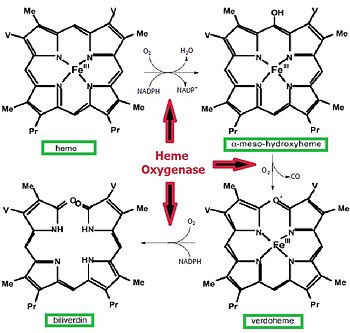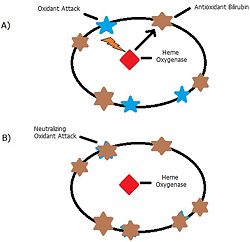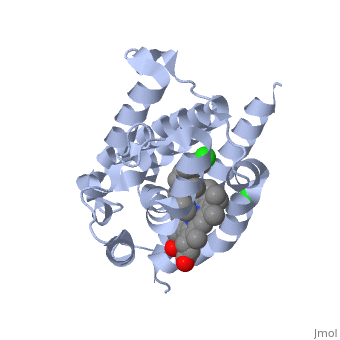Heme oxygenase
From Proteopedia
General InformationHeme Oxygenase (HO) is a member of the Hemoprotein family and catalyzes the Oxygen-dependent cleavage of the porphyrin ring of heme, using reducing equivalents like NADH to produce biliverdin, iron and CO [1]. HO consists of two main isoforms which are present in mammals, HO-1 and HO-2. The two isoforms are products of different genes, are different molecular sizes (32 kDa and 36 kDa respectively) and contain a different primary structure showing only 58% homology [2]. However studies have shown that the two isoforms share a region with 100% secondary structure homology which is believed to be the catalytic site of the protein[1]. The heme oxygenase isoforms are not free throughout the body but sequestered to certain tissues.
LigandHO non-covalently binds to a ligand known as a heme group more specifically Heme B. This Heme is the most abundant heme group commonly recognized for its role in oxygen transport and storage within mammalian tissues [4]. This group is contains a large heterocyclic ring known as a porphyrin ring with an iron atom in the center. The center iron atom serves as a source of electrons for the redox reaction to occur [4]. However this group is susceptible to damage from many stressors including physical shock and therefore needs to be broken down or recycled when theses stressors occur [1]. Structure
Of the four meso edges of the heme only one remains exposed (α-meso edge) while the rest remain buried in the protein [2]. The exposed edge is the target of the HO reaction and requires the correct orientation for the hydroxylation reaction to occur[6]. This orientation is aided by the charges associated with the propionate residues on the heme. The residues of Lys 179, Arg 183, Lys 18 Lys 22 and Tyr 134 are all near the propionates to anchor it via non convalent bonds so the a-meso carbon is in position for the hydroxylation reaction[8]. The propinates are located on the opposite side as the α-meso edge. The vinyl and methyl heme substituents do not appear to be important in orienting the heme due to the fact that they may be disordered about the y- axis which would change only the location of the methyl and vinyl groups while retaining the position of the propionates and the a-meso edge [8]. . FunctionHeme Oxygenase has two main functions, firstly it recycles iron supplies within the cell to maintain homeostasis and secondly it produces a product (biliverdin) that can be converted to a powerful antioxidant (bilirubin) which can aid in preventing oxidative cell damage [6]. The overall reaction consists of three sequential oxidation steps. In the first step the Oxygen bound to the heme iron is activated to become hydroperoxide. The production of α-hydroxyheme is accomplished by the electrophilic addition of its terminal oxygen to the α-meso carbon [6]. Then Heme Oxygenase converts α-hydroxyheme to verdoheme with the removal of the CO at the α-meso carbon (approximately 85% of CO produced under normal conditions is from this reaction)[6]. Lastly, the oxygen bridge of verdoheme is cleaved to produce biliverdin-iron chelate before the dissociation of the iron to biliverdin. (Figure 1) The electrons required for catalytic turnover of the enzyme are provided, in mammalian systems, by NADPH-cytochrome P450 reductase[6]. Studies suggest that the CO produced by the heme oxygenase reaction also functions to have anti-inflammatory, anti-proliferative and anti-apoptotic effects [7] to prevent cell damaage. A classic example of this reaction is a bruise. When tissue obtains a hard hit the erythrocytes release the heme creating a Red color. The heme then gets converted to biliverdin via heme oxygenase to produce a green color. Finally the conversion of biliverdin to bilirubin displays a yellow color. Therefore the reaction can be visibly observed [9]..
Medical Significance and Future ImplicationsThe lungs are a major target for various inflammatory, oxidative, carcinogenic and infectious pressures, which have the ability to result in a range of lung diseases like chronic obstructive lung diseases (COLD)[10]. The Induction of HO-1 is a crucial defense mechanism during these acute and chronic lung processes. The defense is obtained from the anti-oxidant, anti-inflammatory and anti-apoptotic properties of the products formed from the HO reaction [10]. (Figure 2) Therefore manipulation of the HO reaction and HO can have immense therapeutic potential against a range of lung diseases, if optimal levels of incorporation can be achieved. The products of the HO reaction are not just beneficial for lung diseases but also have a cytoprotective effect through the p38-MAPK pathway, and are a potential therapeutic treatment in cancer[1]. Recent studies have also shown that inhibition of the HO-1 reduces Kaposi sarcoma tumor growth [1]. Therefore future implications on regulating and manipulating this protein can have a massive impact on medical treatments. Additional ResourcesFor additional information, see: 3D structures of heme oxygenase
|
| |||||||||||
References
- ↑ 1.0 1.1 1.2 1.3 1.4 1.5 1.6 1.7 Sugishima M, Higashimoto Y, Oishi T, Takahashi H, Sakamoto H, Noguchi M, Fukuyama K. X-ray crystallographic and biochemical characterization of the inhibitory action of an imidazole-dioxolane compound on heme oxygenase. Biochemistry. 2007 Feb 20;46(7):1860-7. Epub 2007 Jan 25. PMID:17253780 doi:10.1021/bi062264p
- ↑ 2.0 2.1 Lad L, Ortiz de Montellano PR, Poulos TL. Crystal structures of ferrous and ferrous-NO forms of verdoheme in a complex with human heme oxygenase-1: catalytic implications for heme cleavage. J Inorg Biochem. 2004 Nov;98(11):1686-95. PMID:15522396 doi:10.1016/j.jinorgbio.2004.07.004
- ↑ Otterbein LE, Soares MP, Yamashita K, Bach FH. Heme oxygenase-1: unleashing the protective properties of heme. Trends Immunol. 2003 Aug;24(8):449-55. PMID:12909459
- ↑ 4.0 4.1 Caughey WS, Smythe GA, O'Keeffe DH, Maskasky JE, Smith MI. Heme A of cytochrome c oxicase. Structure and properties: comparisons with hemes B, C, and S and derivatives. J Biol Chem. 1975 Oct 10;250(19):7602-22. PMID:170266
- ↑ Bonkovsky HL, Healey JF, Pohl J. Purification and characterization of heme oxygenase from chick liver. Comparison of the avian and mammalian enzymes. Eur J Biochem. 1990 Apr 20;189(1):155-66. PMID:2158889
- ↑ 6.0 6.1 6.2 6.3 6.4 6.5 Rahman MN, Vlahakis JZ, Szarek WA, Nakatsu K, Jia Z. X-ray Crystal Structure of Human Heme Oxygenase-1 in Complex with 1-(Adamantan-1-yl)-2-(1H-imidazol-1-yl)ethanone: A Common Binding Mode for Imidazole-Based Heme Oxygenase-1 Inhibitors. J Med Chem. 2008 Sep 18. PMID:18798608 doi:10.1021/jm800505m
- ↑ 7.0 7.1 Maines MD. Heme oxygenase: function, multiplicity, regulatory mechanisms, and clinical applications. FASEB J. 1988 Jul;2(10):2557-68. PMID:3290025
- ↑ 8.0 8.1 Lee TS, Chau LY. Heme oxygenase-1 mediates the anti-inflammatory effect of interleukin-10 in mice. Nat Med. 2002 Mar;8(3):240-6. PMID:11875494 doi:10.1038/nm0302-240
- ↑ Evans JP, Niemevz F, Buldain G, de Montellano PO. Isoporphyrin intermediate in heme oxygenase catalysis. Oxidation of alpha-meso-phenylheme. J Biol Chem. 2008 Jul 11;283(28):19530-9. Epub 2008 May 16. PMID:18487208 doi:10.1074/jbc.M709685200
- ↑ 10.0 10.1 Raval CM, Lee PJ. Heme oxygenase-1 in lung disease. Curr Drug Targets. 2010 Dec;11(12):1532-40. PMID:20704548
This page originally authored by Barinder Chahal



